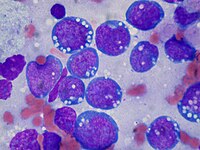
Photo from wikipedia
The treatment of low‐tumour burden follicular lymphoma (LTBFL) remains a challenge. Rituximab‐based strategies may be improved by adding chemotherapy. This Lymphoma Study Association multicentre phase II study assessed rituximab and… Click to show full abstract
The treatment of low‐tumour burden follicular lymphoma (LTBFL) remains a challenge. Rituximab‐based strategies may be improved by adding chemotherapy. This Lymphoma Study Association multicentre phase II study assessed rituximab and bendamustine in 63 patients with untreated LTBFL who were aged over 60 years old and had a follicular lymphoma International Prognostic Index (FLIPI) score ≥2. Induction comprised 4 weekly cycles of rituximab 375 mg/m2 intravenously combined with 2 cycles of bendamustine 90 mg/m2 days 1–2 with a 28‐day interval, followed by twelve cycles of 375 mg/m2 rituximab maintenance therapy every 8 weeks. The primary endpoint was complete response (CR)/unconfirmed CR (CRu), at 12 weeks. Median age was 67·4 years and median FLIPI was 3. Ultimately, 18 patients (29%) had high tumour burden according to Groupe d'Etude des Lymphomes Folliculaires criteria. The 12‐week CR/CRu rate was 54·0% and the overall response rate was 93·7%. Surprisingly, 3 patients died during maintenance (2 sepsis, 1 neoplasm). Progression‐free survival was 85·4% at 24 months. In LTBFL patients with FLIPI ≥2, two cycles of rituximab and bendamustine result in a CR rate of 54·0%. However, the treatment‐related deaths observed do not allow this regimen to be recommended for LTBFL patients aged over 60 years.
Journal Title: British Journal of Haematology
Year Published: 2018
Link to full text (if available)
Share on Social Media: Sign Up to like & get
recommendations!